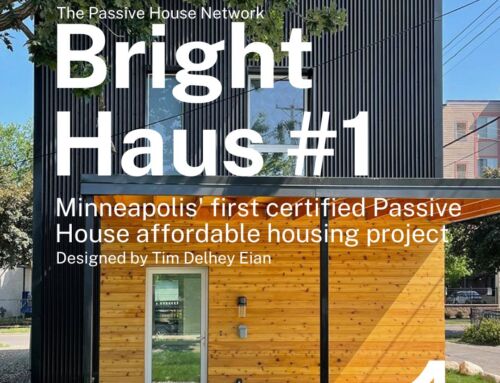Passive House is a building standard. It is a voluntary international building standard developed by the Passive House Institute (PHI), located in Darmstadt, Germany – referred to also as The Passive House Standard. The Passive House Standard is composed of several strict performance requirements for new building construction. For the renovation of existing buildings PHI developed a similarly strict if slightly more lenient performance standard. The resulting performance represents a roughly 90% reduction in heating and cooling energy usage and up to a 75% reduction in primary energy usage from existing building stock – meant to aggressively meet our climate crises carbon reduction requirements.
The Passive House Standard for new buildings addresses energy usage and building airtightness:
· Space Heating Energy Demand: 15 kilowatt hours per square meter of Treated Floor Area[1] per year or 10Watts per square meter peak demand. (Or in Imperial units 4.75 kBTU/sfyr and 3.2 kBTU/sfyr respectively.)
· Space Cooling Energy Demand: match the heat demand requirements but with a small additional allowance for dehumidification.
· Primary Energy Demand: based on a calculation of the total energy to be used in the building operations (heating + cooling + lighting + equipment + hot water, etc…). Or 120 kilowatt hours per square meter of Treated Floor Area per year. (Or in Imperial units 38.0 kBTU/sfyr.)
· Airtight Enclosure: A target airtightness of 0.3 air changes per hour at 50 Pascals pressure (ACH50) that is verified with an onsite blower door test (pressurized and depressurized). The allowable limit is 0.6ACH50.[2] (For a building with a volume above 4,000 cubic meters (or 140,000 cubic feet) measurement relative to surface area is recommended, with maximum leakage of 0.6m3/hr*m2 or 0.0033CFM/ft2 at 50 Pascals pressure.)
To help practitioners achieve the criteria, PHI has developed Passive House Certified Components for such critical items as windows and heat-recovery ventilation units and Certified Passive House Consultants and Certified Passive House Tradespersons, to help ensure that the design and construction of Passive Houses are done with the highest competence possible.
A Passive House is a building that is constructed with the Passive House methodology and meets the Passive House Standard criteria. A Passive House can be any type of building: an apartment building, a school, an office building, a factory, a supermarket. Passive Houses are exceptionally comfortable, healthy and affordable to occupy.
A Passive House may become a Certified Passive House. Certification is provided by PHI or another certifier accredited by PHI. A Certified Passive House must also meet additional Passive House comfort criteria and submit extensive documentation including the completed PHPP. Certification is recommended for the unsurpassed quality assurance it provides bringing to the process expertise in cost optimization, detailing and execution. There are different certifications for residential and non-residential as well as building renovations.
However if the building was designed and built with the Passive House methodology, incorporates Passive House components but just missed the required criteria, such as the final airtightness test results, the building may be called a Passive House Project, or more generically a high-performance low-energy building.
The result of all this is a Passive House building with the following qualities:
· Very Energy Efficient: Providing dramatic energy reduction, up to 90% for heating and cooling demand from average existing building stock – in an effort to offer a proportional response to the climate crises. (Note: despite widespread misleading descriptions to the contrary, most cold climate Passive House are still required to have a heating system, it is just a very small heating system, and therefore likely not a traditional heating system.)
· Healthy: Fresh, high-quality indoor air, free of mold, radon and other typical contaminent levels.
· Comfortable: A quiet interior environment with steady temperatures and no drafts.
· Affordable: Construction high-performance added costs are substantially offset by a reduction systems sizing. Because the reduced energy use translates into lower bills and protection from future energy shocks, occupancy is affordable.
· Predictable: An integrated methodology and energy model provides predictability – an essential element in optimizing system sizing and costing.
· Resilient: Passive House buildings help make resilience in three ways. 1) By indefinitely maintaining habitable interior temperatures in freezing weather without power – allowing people to shelter-in-place. 2) Reduced power demand allows power distribution systems to be better managed. 3) Reduced power demand makes Net Zero Energy building readily achievable with rooftop photovoltaic solar panels and/or other renewables.
[1] Treated Floor Area is a specifically defined term and area, that is smaller than gross area or even net interior area – similar but not identical to what one might think of as “carpetable area” where interior wall stairs and unusable space is not included.
[2] The volume used for the airtightness calculation refers to the occupied volume – finish surface to finish surface of each space, where floors and walls are excluded.




